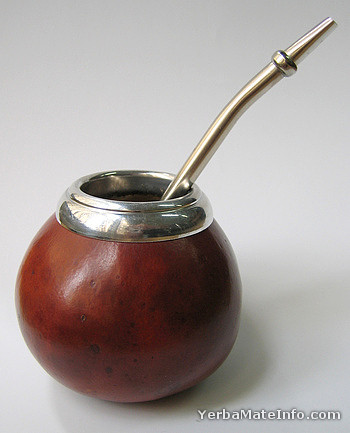

There are different traditional vessels in which yerba mate is served. The most popular ones are made out of calabash, wood or horn. The latter is used exclusively for serving terere, which is cold mate. Using traditional vessels undoubtedly creates an exotic atmosphere and might even add to the flavour of the drink but they are not necessary. Normal cups will be just as good. In South America most containers from which mate is drunk are generally also called mate.
Calabash is an annual climbing plant which grows up to 10 meters in height. It is one of the oldest farming plants in the tropic. It was known in Egypt some 3000 years BC and it was commonly utilized in South America well before Columbus discovered the continent. Mature fruit of the calabash is wooded and can be as long as 80 cm. The fruit can drift on the surface of the ocean for many months and still retain its capacity to germinate. The unripe fruit is used as a vegetable, the pulp of which when boiled has a hard, crispy texture. The ripe fruit pulp is a strong laxative.
A great variety of objects are made out of the mature fruit of the calabash, such as water or oil containers, bowls, pots, traditional masks and drums and various other percussion instruments. Unusually, it also used to make a koteka, a traditional penis protection device worn by men in Papua New Guinea.
The most popular mate vessel, the gourd, is made out of the fruit of the calabash. Calabash can be dyed, sculptured, covered with leather or decorated by metal elements. Some gourds are highly artistic which may be reflected in their price. The opening in the gourd may be finished with a metal ring (virola) which prevents cracking at the edges. It is advisable to keep water in the gourd well below the level of the virola as bacteria and fungus may develop immediately under the virola.
There are two types of popular vessels made out of the fruit of the calabash, depending on which part of the fruit is used:

Calabaza gourd is made out of the lower part of the calabash fruit. This is the most popular and the cheapest vessel but it is requires special care. Calabaza gourd is susceptible to fungus and therefore needs to be kept dry when not in use. Sometimes it can crack. It should be cured before it is first used to remove the remains of the pulp which has very strong laxative properties. During the curing process the walls of gourd will absorb the aroma of yerba mate.
Capacity: usually between 150-350 ml, but can be as low as 80 ml or as high as 500 ml
Porongo guard is made out of the top part of the calabash fruit and has thick, strong walls. It can maintain the temperature of the drink for longer. It is more resilient to cracking and less susceptible to fungus. It is stronger and more resilient to damage than calabaza guard. The top part of the calabash fruit contains no pulp which makes the curing process prior to use much simpler and faster. Porongo does not have a flat bottom therefore it needs a metal base or some sort of leather legs/support.
Capacity: usually between 250-400 ml, but can be as low as 150 ml or as high as 500 ml

With time, drops of liquid may appear at the bottom of a calabash gourd. This is called the ‘sweating of the gourd’ and is quite normal. Calabash is porous and the infusion can seep through its bottom, especially in new containers. Placing a mat or a saucer under the gourd will prevent staining of the table. Some gourds come with a special tripod or with a metal or leather base.
In colder climates the vessel needs special care. After the last drink, the gourd should be emptied of all the leaves, rinsed and left to dry. It may be dried inside with a tea towel and placed in a warm place, such as the top of a radiator, and this will speed up the drying process. The gourd should not be left with wet leaves inside.
The gourd may become dull after a while. Wiping it with a kitchen towel soaked in oil will bring back the glossy surface.
The longer the gourd is in use, the better its condition, as long as care is taken to prevent fungi and fermenting bacteria on its surface, as they will make the gourd unusable. Local people in Argentina are unhappy to part with their gourds, even the old and broken ones. They repair the cracks using sheep intestines. They turn the wet intestines inside out and place the gourd inside. As the intestines dry out they shrink and stiffen thus closing the crack of the gourd. The intestines add a decorative element to the gourd as they look like honeycomb. In some parts of Argentine a cracked gourd is repaired by sewing with horse hair.